| 1 |
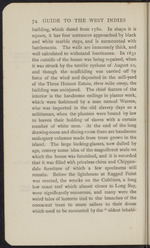 |
“...it is
square, it has four entrances approached by black
and white marble steps, and is surmounted with
battlements. The walls are immensely thick, and
well calculated to withstand hurricanes. In 1831
the outside of the house was being repaired, when
it was struck by the terrific cyclone of August xo,
and though the scaffolding was carried off by
force of the wind and deposited in the mill-yard
of the Three Houses Estate, three miles away, the
building was uninjured. The chief feature of the
interior is the handsome ceilings in plaster work,
which were fashioned by a man named Warren,
who was imported in the old slavery days as a
militiaman, when the planters were bound by law
to leaven their holding of slaves with a certain
number of white men. At the end of the long
drawing-room and dining-room there are handsome
mahogany columns made from trees grown in the
island. The large looking-glasses, now dulled by
age, convey some idea of the magnificent scale on
which the house was furnished...”
|
|
| 2 |
 |
“...BRITISH GUIANA
79
The interior of the colony consists of swampy
grass plains called savannahs, dense forests and
bush, and ranges of mountains. The primitive
forests are only occupied by a few Indians, with
here and there a wood-cutter’s, a gold-digger’s, or I
a diamond-washer’s camp. A series of sandhills,
now covered by tall forest trees, runs parallel to
the sea-coast beyond the savannahs, and it is
supposed that they were left by the receding sea
in remote times. The highest of the mountains
is Roraima (8740 feet), which, though precipitous
near the summit, has been ascended on several
occasions, the first ascent having been made in
1884 by Mr. (now Sir) Everard im Thurn and Mr.
H. J. Perkins, who were also among the first to
visit the Kaieteur Falls on the Potaro, a tributary
of the Essequebo, which are of great grandeur.
The colony has four great rivers, the Demerara,
the Essequebo, and the Berbice, which give their
names to the three counties, and the Corentyn, I
which divides British...”
|
|
| 3 |
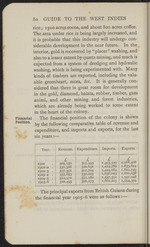 |
“...Financial
Position.
80 GUIDE TO THE WEST INDIES
rice; 1500 acres cocoa, and about 800 acres coffee.
The area under rice is being largely increased, and
it is probable that this industry will undergo con-
siderable development in the near future. In the
interior, gold is recovered by “placer” washing, and
also to a lesser extent by quartz mining, and much is
expected from a system of dredging and hydraulic
washing, which is being experimented with. Many
kinds of timbers are exported, including the valu-
able greenheart, mora, &c. It is generally con-
sidered that there is great room for development
in the gold, diamond, balata, rubber, timber, gum
animi, and other mining and forest industries,
which are already being worked to some extent
in the heart of the colony.
The financial position of the colony is shown
by the following comparative table of revenue and
expenditure, and imports and exports, for the last
six years:—
Year. Revenue. Expenditure. Imports. Exports.
1900 1901- 2 . 1902-...”
|
|
| 4 |
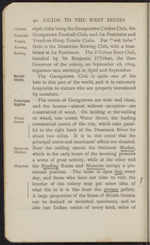 |
“...Street, the leading
commercial centre of the city, which runs paral-
lel to the right bank of the Demerara River for
about two miles. It is in this street that the
principal stores and merchants’ offices are situated.
Near the stelling stands the Stabroek Market,
which in the early hours of the morning presents
a scene of great activity, while at the other end
the Reading Room and Museum occupy a pro-
minent position. The latter is open free every
day, and those who have not time to visit the
interior of the colony may get some idea of
what life in it is like from the picture gallery.
A large proportion of the fauna of British Guiana
can be studied as mounted specimens, and so
also can Indian curios of every kind, relics of...”
|
|
| 5 |
 |
“...i°6 GUIDE TO THE WEST INDIES
island for Spain; but most of the colonists were
apathetic, and those who were not joined the
Maroons,1 the runaway slaves, in the interior of
the island, and so began the long series of
Maroon wars. In June 1670 the British occupa-
tion of Jamaica was formally recognised by the
Treaty of Madrid. The colonisation of Jamaica
was proceeded with, and there was a large influx
of soldiers, who did not make good colonists, and
also of very undesirable refugees. A quantity
of settlers also came from Nevis and other West
Indian Islands. Jamaica became one of the
headquarters of the buccaneers, a daring band
of freebooters of all nationalities, who were
deadly opposed to the rule of Spain. They
derived their name from South American hunters,
who joined the pirates known as flibustiers from
the Dutch flyboats in which they made their
expeditions. These hunters were in the habit of
I drying their meat on wooden grills called boucans,
I and the name buccaneers was given...”
|
|
| 6 |
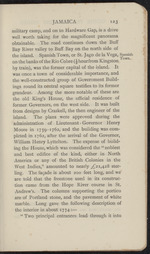 |
“...The expense of build-
ing the House, which was considered the “ noblest
and best edifice of the kind, either in North
America or any of the British Colonies in the
West Indies,” amounted to nearly ,£21,428 ster-
ling. The facade is about 200 feet long, and we
are told that the freestone used in its construc-
tion came from the Hope River course in St.
Andrew’s. The columns supporting the portico
are of Portland stone, and the pavement of white
marble. Long gave the following description of
the interior in about 17 74 :—
“ Two principal entrances lead through it into...”
|
|
| 7 |
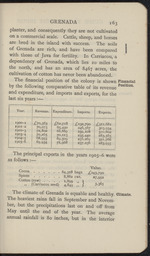 |
“...237.256 £311,681 303.934 310,602 283.565 321.766 283.955
The principal exports in the years 1905—6 were
as follows:—
Value.
S'0.001........64.3i8 bags £243,790
°Plces..........8,862 cwt. 27,992
Cotton (raw) .... 1,899 „ )
,, (Carriacou seed) 4,849 ,, ƒ 3.365
The climate of Grenada is equable and healthy. Climate.
The heaviest rains fall in September and Novem-
ber, but the precipitations last on and off from
May until the end of the year. The average
annual rainfall is 80 inches, but in the interior...”
|
|
| 8 |
 |
“...ANTIGUA
209
the earthquake which took place immediately
after morning service on Sunday, 8th February
1843. The Cathedral occupies the Very spot where
the militia were stationed in 1710, when they were
ordered to fire on the then Governor, Colonel
Park, whose tyranny and arbitrary conduct ren-
dered him detested in the island. It is solidly
built, and cruciform in shape, while its length is
130 feet and its breadth 50 feet. The interior, which
is fitted with galleries, is lined with stout pitch
pine as a precaution against earthquakes. The
roof of the Cathedral is maintained at the ex-
pense of the Government, who use it to collect
rain-water, which is stored in large cisterns under-
ground ! The monuments in the old church
were many, and the inscriptions upon them were
exceedingly interesting, the oldest being a stone
slab in the chancel to the memory of Mrs. Gilbert,
the wife of the Mr. Gilbert who introduced Metho-
dism into Antigua, and who died in 1747. In the
south aisle were monuments...”
|
|
| 9 |
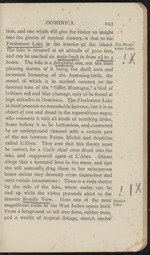 |
“...DOMINICA
243
tion, and one which will give the visitor an insight
into the glories of tropical scenery, is that to the
Freshwater Lake in the interior of the island. The Fresh-*
i'he lake is situated at an altitude of 3000 feet,water Lake'
and can be reached on mule-back in from 2 J to 3 I Y
hours. The ride is a delightful one, not the least ♦ A
pleasing feature of it being the shrill note and
incessant humming of the humming-birds, the
sound of which is in marked contrast to the
funereal tone of the “ Sifflet Montagne,” a bird of
brilliant red and blue plumage, only to be found at
high altitudes in Dominica. The vFreshwater Lake
in itself presents no remarkable features; but it is an
object of awe and dread to the superstitious negro,
who connects it with all kinds of terrifying fables.
Some believe it to be bottomless, and connected
by an underground channel with a certain part
of the sea between Pointe Michel and Soufrière
called L’Abys. They aver that this theory must
be correct, for...”
|
|
| 10 |
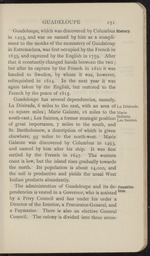 |
“...north-west. Marie
Galante was discovered by Columbus in 1493,
and named by him after his ship. It was first
settled by the French in 1647. The western
coast is low, but the island rises gradually towards
the north. Its population is about 14,000, and
the soil is productive and yields the usual West
Indian products abundantly.
The administration of Guadeloupe and its de- Constitu-
pendencies is vested in a Governor, who is assistedtion'
by a Privy Council and has under his order a
Director of the Interior, a Procurator-General, and
a Paymaster. There is also an elective General
Council. The colony is divided into three arron-...”
|
|
| 11 |
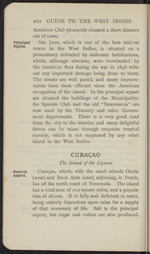 |
“...fortifications,
which, although obsolete, were bombarded by
the American fleet during the war in 1898 with-
out any important damage being done to them.
The streets are well paved, and many improve-
ments have been effected since the American
occupation of the island. In the principal square
are situated the buildings of the Municipality;
the Spanish Club and the old “Intervencia” are
now used by the Treasury and other Govern-
ment departments. There is a very good road
from the city to the interior, and many delightful
drives can be taken through exquisite tropical
scenery, which is not surpassed by any other
island in the West Indies.
CURACAO
The Island of the Liqueur
Curasao, which, with the small islands Oruba
(west) and Buen Ayre (east) adjoining, is Dutch,
lies off the north coast of Venezuela. The island
has a total area of 212 square miles, and a popula-
tion of 28,000. It is hilly and deficient in water,
being entirely dependent upon rains for a supply
of that necessary of life...”
|
|
| 12 |
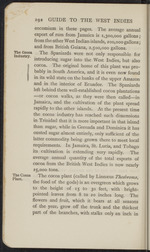 |
“...2 9* GUIDE TO THE WEST INDIES
encomium in these pages. The average annual
export of rum from Jamaica is 1,300,000 gallons j
from the other West Indian islands, 200,000 gallons,
and from British Guiana, 2,500,000 gallons.
todust^a The SPaniards were not only responsible for
introducing sugar into the West Indies, but also
I cocoa. The original home of this plant was pro-
I bably in South America, and it is even now found
in its wild state on the banks of the upper Amazon
and in the interior of Ecuador. The Spaniards
left behind them well-established cocoa plantations
—or cocoa walks, as they were then called—in
Jamaica, and the cultivation of the plant spread
rapidly to the other islands. At the present time
the cocoa industry has reached such dimensions
in Trinidad that it is more important in that island
than sugar, while in Grenada and Dominica it has
ousted sugar almost entirely, only sufficient of the
latter commodity being grown there to meet local
requirements. In Jamaica, St. Lucia...”
|
|
